Oncology Nursing: Practice Change, Caring Culture, and Analysis Report
VerifiedAdded on 2023/01/19
|6
|1374
|97
Report
AI Summary
This report analyzes the caring culture within oncology nursing practice and proposes changes to improve it. The author, an oncology nurse with eight years of experience, discusses the challenges of managing cancer cases, emphasizing the need for practice changes guided by evidence-based guidelines. The report details the use of emotional touchpoints to gather evidence of the workplace culture from a compassionate care perspective. The author used these touchpoints at specific times (meal times, arriving in the wards, going for treatment, visiting times, medication times and nighttime) to connect with patients' emotions and gather information. A thematic analysis of the findings reveals key themes related to patient-centered care, shared decision-making, and the use of empathic approaches. The author recommends strengthening nursing education and training to bridge knowledge gaps and promote non-pharmacological and pharmacological interventions. The report concludes by highlighting the importance of a patient-centered approach to improve the quality of care in oncology nursing.
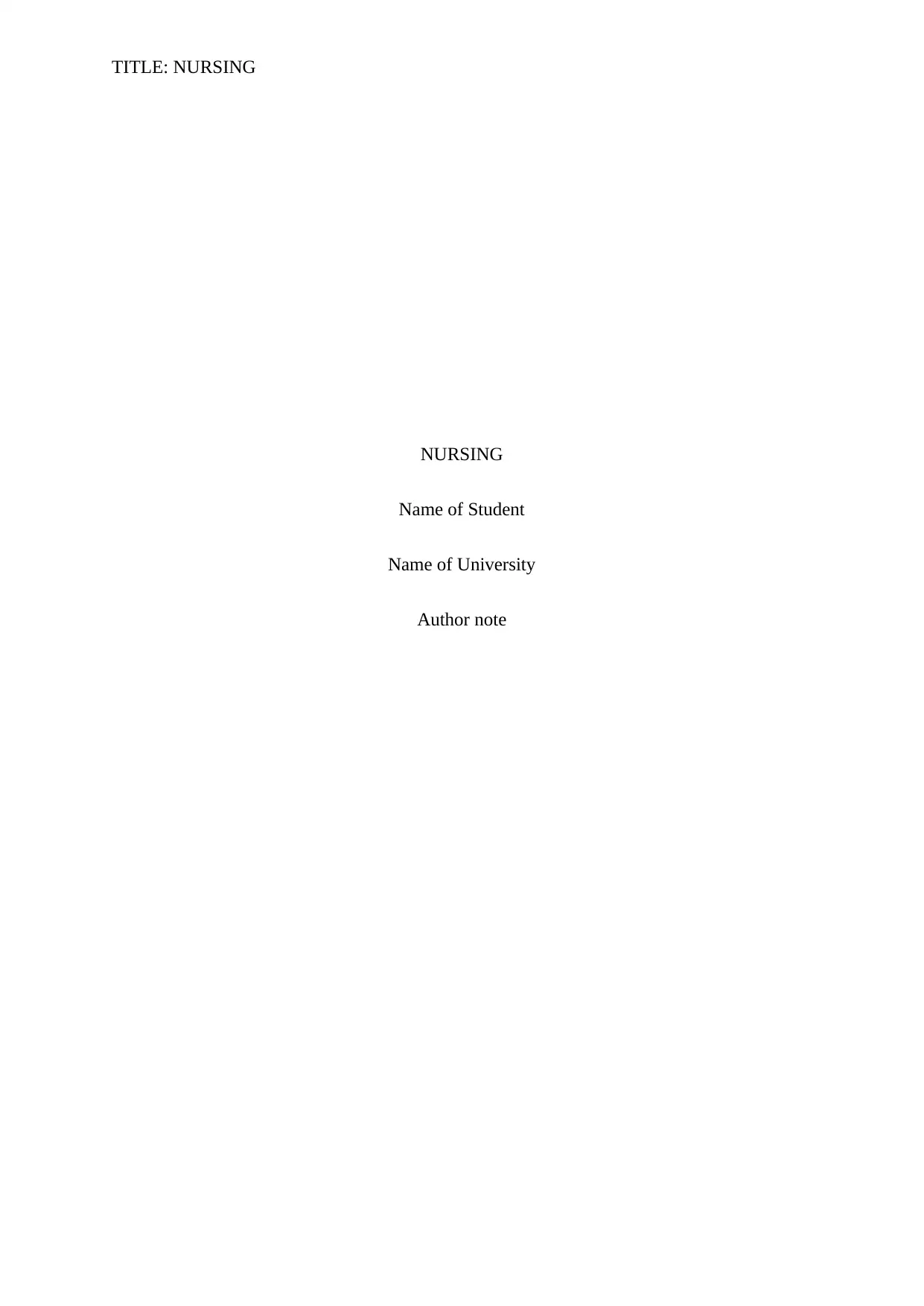
TITLE: NURSING
NURSING
Name of Student
Name of University
Author note
NURSING
Name of Student
Name of University
Author note
Paraphrase This Document
Need a fresh take? Get an instant paraphrase of this document with our AI Paraphraser
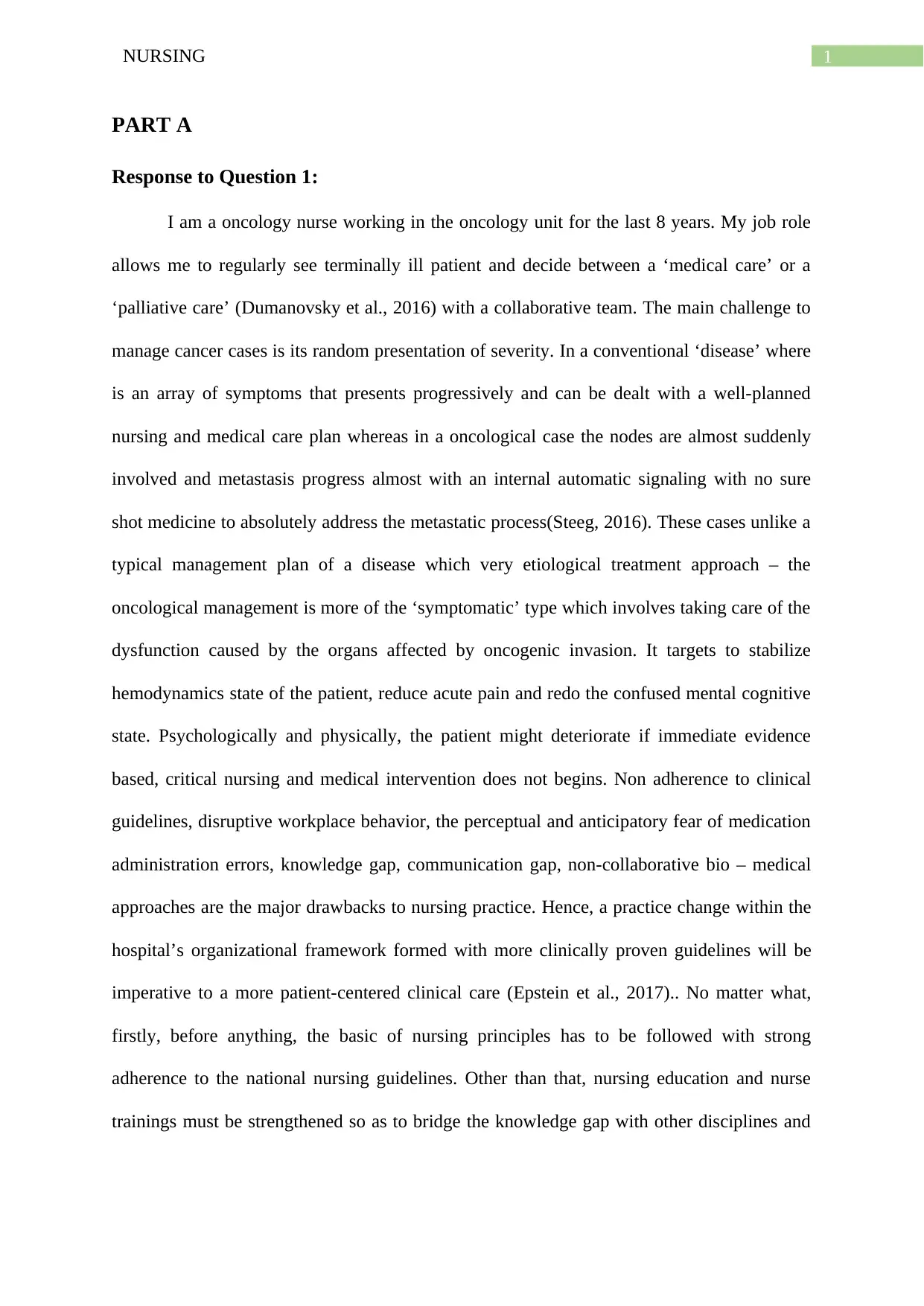
1NURSING
PART A
Response to Question 1:
I am a oncology nurse working in the oncology unit for the last 8 years. My job role
allows me to regularly see terminally ill patient and decide between a ‘medical care’ or a
‘palliative care’ (Dumanovsky et al., 2016) with a collaborative team. The main challenge to
manage cancer cases is its random presentation of severity. In a conventional ‘disease’ where
is an array of symptoms that presents progressively and can be dealt with a well-planned
nursing and medical care plan whereas in a oncological case the nodes are almost suddenly
involved and metastasis progress almost with an internal automatic signaling with no sure
shot medicine to absolutely address the metastatic process(Steeg, 2016). These cases unlike a
typical management plan of a disease which very etiological treatment approach – the
oncological management is more of the ‘symptomatic’ type which involves taking care of the
dysfunction caused by the organs affected by oncogenic invasion. It targets to stabilize
hemodynamics state of the patient, reduce acute pain and redo the confused mental cognitive
state. Psychologically and physically, the patient might deteriorate if immediate evidence
based, critical nursing and medical intervention does not begins. Non adherence to clinical
guidelines, disruptive workplace behavior, the perceptual and anticipatory fear of medication
administration errors, knowledge gap, communication gap, non-collaborative bio – medical
approaches are the major drawbacks to nursing practice. Hence, a practice change within the
hospital’s organizational framework formed with more clinically proven guidelines will be
imperative to a more patient-centered clinical care (Epstein et al., 2017).. No matter what,
firstly, before anything, the basic of nursing principles has to be followed with strong
adherence to the national nursing guidelines. Other than that, nursing education and nurse
trainings must be strengthened so as to bridge the knowledge gap with other disciplines and
PART A
Response to Question 1:
I am a oncology nurse working in the oncology unit for the last 8 years. My job role
allows me to regularly see terminally ill patient and decide between a ‘medical care’ or a
‘palliative care’ (Dumanovsky et al., 2016) with a collaborative team. The main challenge to
manage cancer cases is its random presentation of severity. In a conventional ‘disease’ where
is an array of symptoms that presents progressively and can be dealt with a well-planned
nursing and medical care plan whereas in a oncological case the nodes are almost suddenly
involved and metastasis progress almost with an internal automatic signaling with no sure
shot medicine to absolutely address the metastatic process(Steeg, 2016). These cases unlike a
typical management plan of a disease which very etiological treatment approach – the
oncological management is more of the ‘symptomatic’ type which involves taking care of the
dysfunction caused by the organs affected by oncogenic invasion. It targets to stabilize
hemodynamics state of the patient, reduce acute pain and redo the confused mental cognitive
state. Psychologically and physically, the patient might deteriorate if immediate evidence
based, critical nursing and medical intervention does not begins. Non adherence to clinical
guidelines, disruptive workplace behavior, the perceptual and anticipatory fear of medication
administration errors, knowledge gap, communication gap, non-collaborative bio – medical
approaches are the major drawbacks to nursing practice. Hence, a practice change within the
hospital’s organizational framework formed with more clinically proven guidelines will be
imperative to a more patient-centered clinical care (Epstein et al., 2017).. No matter what,
firstly, before anything, the basic of nursing principles has to be followed with strong
adherence to the national nursing guidelines. Other than that, nursing education and nurse
trainings must be strengthened so as to bridge the knowledge gap with other disciplines and
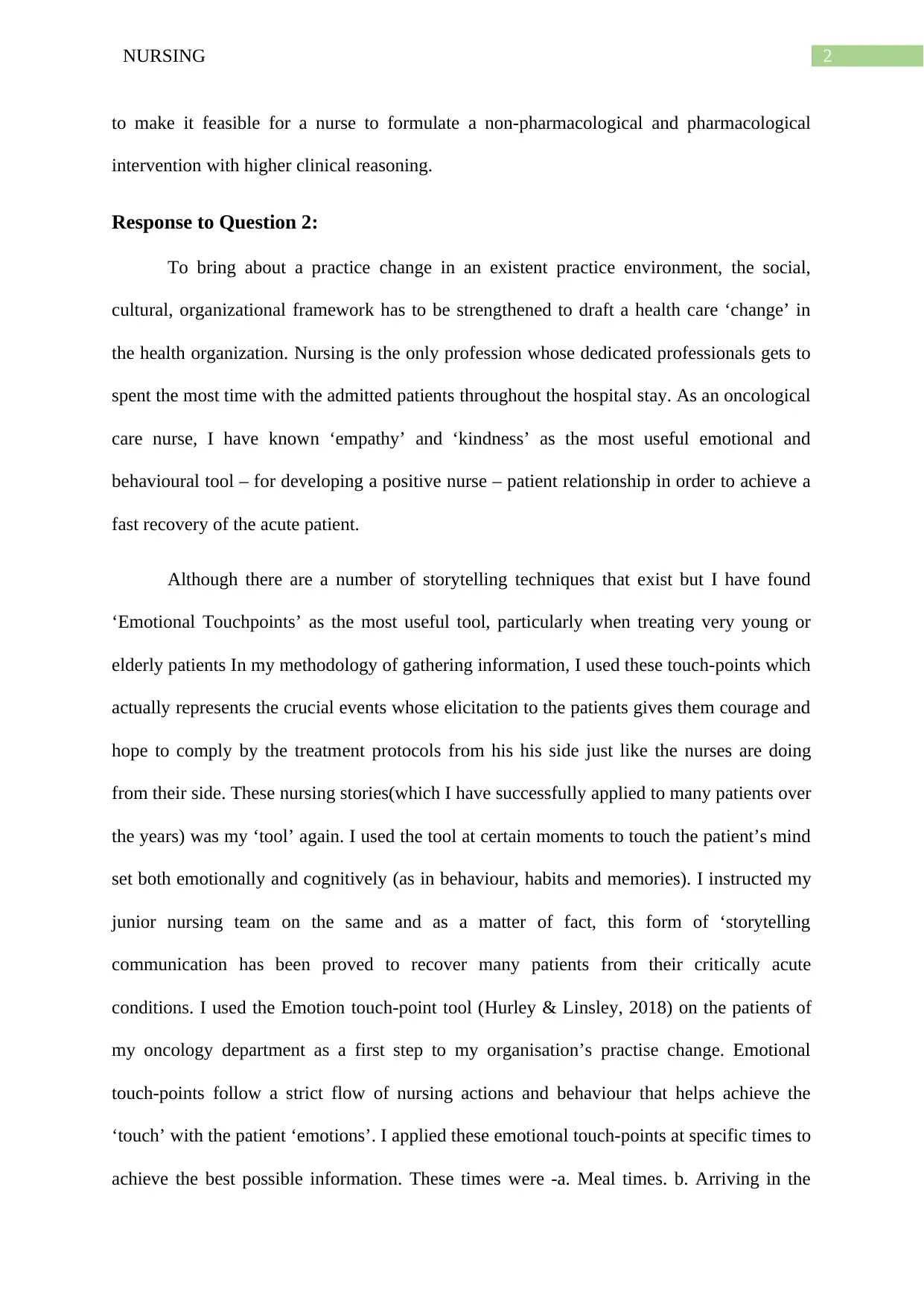
2NURSING
to make it feasible for a nurse to formulate a non-pharmacological and pharmacological
intervention with higher clinical reasoning.
Response to Question 2:
To bring about a practice change in an existent practice environment, the social,
cultural, organizational framework has to be strengthened to draft a health care ‘change’ in
the health organization. Nursing is the only profession whose dedicated professionals gets to
spent the most time with the admitted patients throughout the hospital stay. As an oncological
care nurse, I have known ‘empathy’ and ‘kindness’ as the most useful emotional and
behavioural tool – for developing a positive nurse – patient relationship in order to achieve a
fast recovery of the acute patient.
Although there are a number of storytelling techniques that exist but I have found
‘Emotional Touchpoints’ as the most useful tool, particularly when treating very young or
elderly patients In my methodology of gathering information, I used these touch-points which
actually represents the crucial events whose elicitation to the patients gives them courage and
hope to comply by the treatment protocols from his his side just like the nurses are doing
from their side. These nursing stories(which I have successfully applied to many patients over
the years) was my ‘tool’ again. I used the tool at certain moments to touch the patient’s mind
set both emotionally and cognitively (as in behaviour, habits and memories). I instructed my
junior nursing team on the same and as a matter of fact, this form of ‘storytelling
communication has been proved to recover many patients from their critically acute
conditions. I used the Emotion touch-point tool (Hurley & Linsley, 2018) on the patients of
my oncology department as a first step to my organisation’s practise change. Emotional
touch-points follow a strict flow of nursing actions and behaviour that helps achieve the
‘touch’ with the patient ‘emotions’. I applied these emotional touch-points at specific times to
achieve the best possible information. These times were -a. Meal times. b. Arriving in the
to make it feasible for a nurse to formulate a non-pharmacological and pharmacological
intervention with higher clinical reasoning.
Response to Question 2:
To bring about a practice change in an existent practice environment, the social,
cultural, organizational framework has to be strengthened to draft a health care ‘change’ in
the health organization. Nursing is the only profession whose dedicated professionals gets to
spent the most time with the admitted patients throughout the hospital stay. As an oncological
care nurse, I have known ‘empathy’ and ‘kindness’ as the most useful emotional and
behavioural tool – for developing a positive nurse – patient relationship in order to achieve a
fast recovery of the acute patient.
Although there are a number of storytelling techniques that exist but I have found
‘Emotional Touchpoints’ as the most useful tool, particularly when treating very young or
elderly patients In my methodology of gathering information, I used these touch-points which
actually represents the crucial events whose elicitation to the patients gives them courage and
hope to comply by the treatment protocols from his his side just like the nurses are doing
from their side. These nursing stories(which I have successfully applied to many patients over
the years) was my ‘tool’ again. I used the tool at certain moments to touch the patient’s mind
set both emotionally and cognitively (as in behaviour, habits and memories). I instructed my
junior nursing team on the same and as a matter of fact, this form of ‘storytelling
communication has been proved to recover many patients from their critically acute
conditions. I used the Emotion touch-point tool (Hurley & Linsley, 2018) on the patients of
my oncology department as a first step to my organisation’s practise change. Emotional
touch-points follow a strict flow of nursing actions and behaviour that helps achieve the
‘touch’ with the patient ‘emotions’. I applied these emotional touch-points at specific times to
achieve the best possible information. These times were -a. Meal times. b. Arriving in the
⊘ This is a preview!⊘
Do you want full access?
Subscribe today to unlock all pages.

Trusted by 1+ million students worldwide
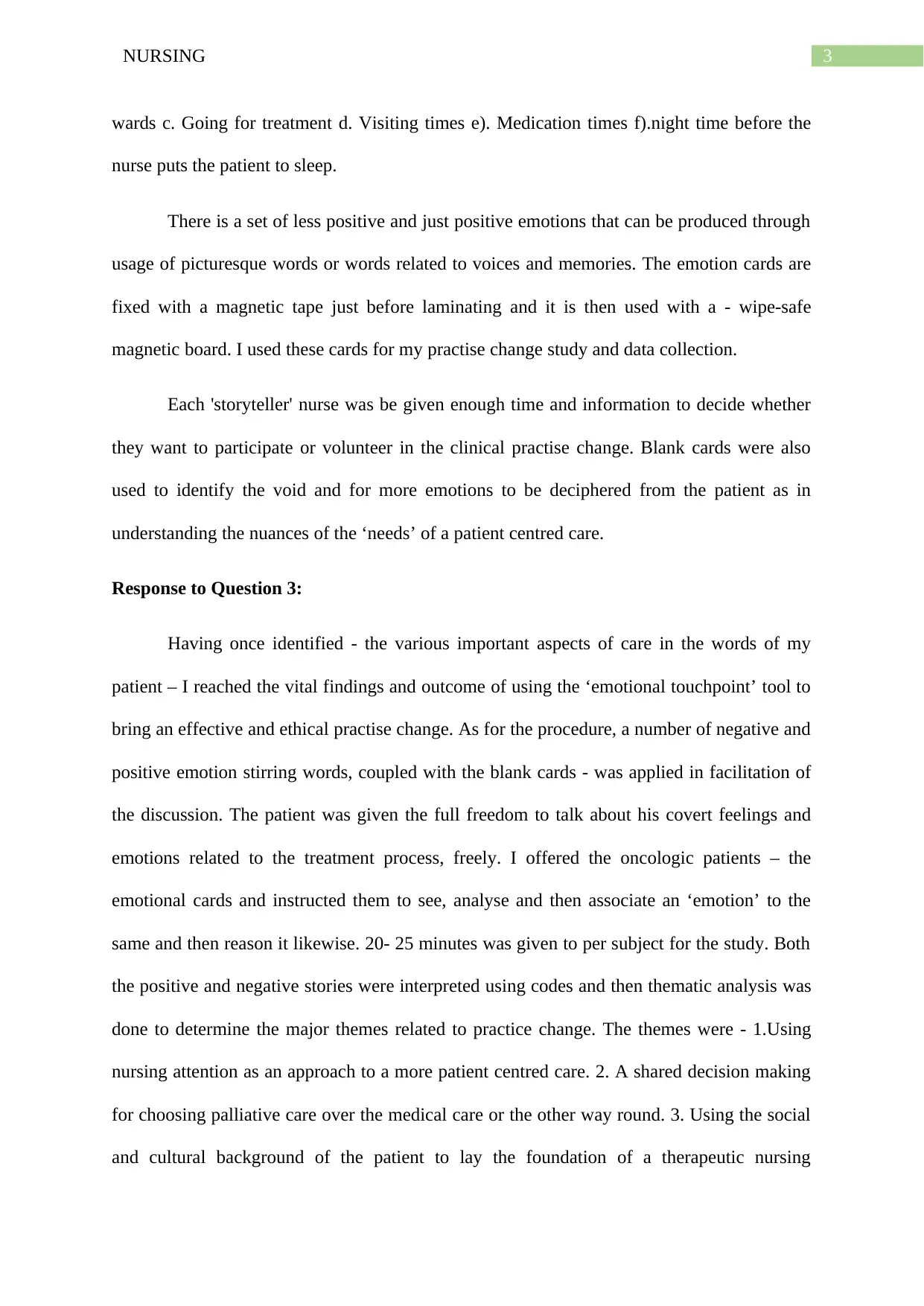
3NURSING
wards c. Going for treatment d. Visiting times e). Medication times f).night time before the
nurse puts the patient to sleep.
There is a set of less positive and just positive emotions that can be produced through
usage of picturesque words or words related to voices and memories. The emotion cards are
fixed with a magnetic tape just before laminating and it is then used with a - wipe-safe
magnetic board. I used these cards for my practise change study and data collection.
Each 'storyteller' nurse was be given enough time and information to decide whether
they want to participate or volunteer in the clinical practise change. Blank cards were also
used to identify the void and for more emotions to be deciphered from the patient as in
understanding the nuances of the ‘needs’ of a patient centred care.
Response to Question 3:
Having once identified - the various important aspects of care in the words of my
patient – I reached the vital findings and outcome of using the ‘emotional touchpoint’ tool to
bring an effective and ethical practise change. As for the procedure, a number of negative and
positive emotion stirring words, coupled with the blank cards - was applied in facilitation of
the discussion. The patient was given the full freedom to talk about his covert feelings and
emotions related to the treatment process, freely. I offered the oncologic patients – the
emotional cards and instructed them to see, analyse and then associate an ‘emotion’ to the
same and then reason it likewise. 20- 25 minutes was given to per subject for the study. Both
the positive and negative stories were interpreted using codes and then thematic analysis was
done to determine the major themes related to practice change. The themes were - 1.Using
nursing attention as an approach to a more patient centred care. 2. A shared decision making
for choosing palliative care over the medical care or the other way round. 3. Using the social
and cultural background of the patient to lay the foundation of a therapeutic nursing
wards c. Going for treatment d. Visiting times e). Medication times f).night time before the
nurse puts the patient to sleep.
There is a set of less positive and just positive emotions that can be produced through
usage of picturesque words or words related to voices and memories. The emotion cards are
fixed with a magnetic tape just before laminating and it is then used with a - wipe-safe
magnetic board. I used these cards for my practise change study and data collection.
Each 'storyteller' nurse was be given enough time and information to decide whether
they want to participate or volunteer in the clinical practise change. Blank cards were also
used to identify the void and for more emotions to be deciphered from the patient as in
understanding the nuances of the ‘needs’ of a patient centred care.
Response to Question 3:
Having once identified - the various important aspects of care in the words of my
patient – I reached the vital findings and outcome of using the ‘emotional touchpoint’ tool to
bring an effective and ethical practise change. As for the procedure, a number of negative and
positive emotion stirring words, coupled with the blank cards - was applied in facilitation of
the discussion. The patient was given the full freedom to talk about his covert feelings and
emotions related to the treatment process, freely. I offered the oncologic patients – the
emotional cards and instructed them to see, analyse and then associate an ‘emotion’ to the
same and then reason it likewise. 20- 25 minutes was given to per subject for the study. Both
the positive and negative stories were interpreted using codes and then thematic analysis was
done to determine the major themes related to practice change. The themes were - 1.Using
nursing attention as an approach to a more patient centred care. 2. A shared decision making
for choosing palliative care over the medical care or the other way round. 3. Using the social
and cultural background of the patient to lay the foundation of a therapeutic nursing
Paraphrase This Document
Need a fresh take? Get an instant paraphrase of this document with our AI Paraphraser
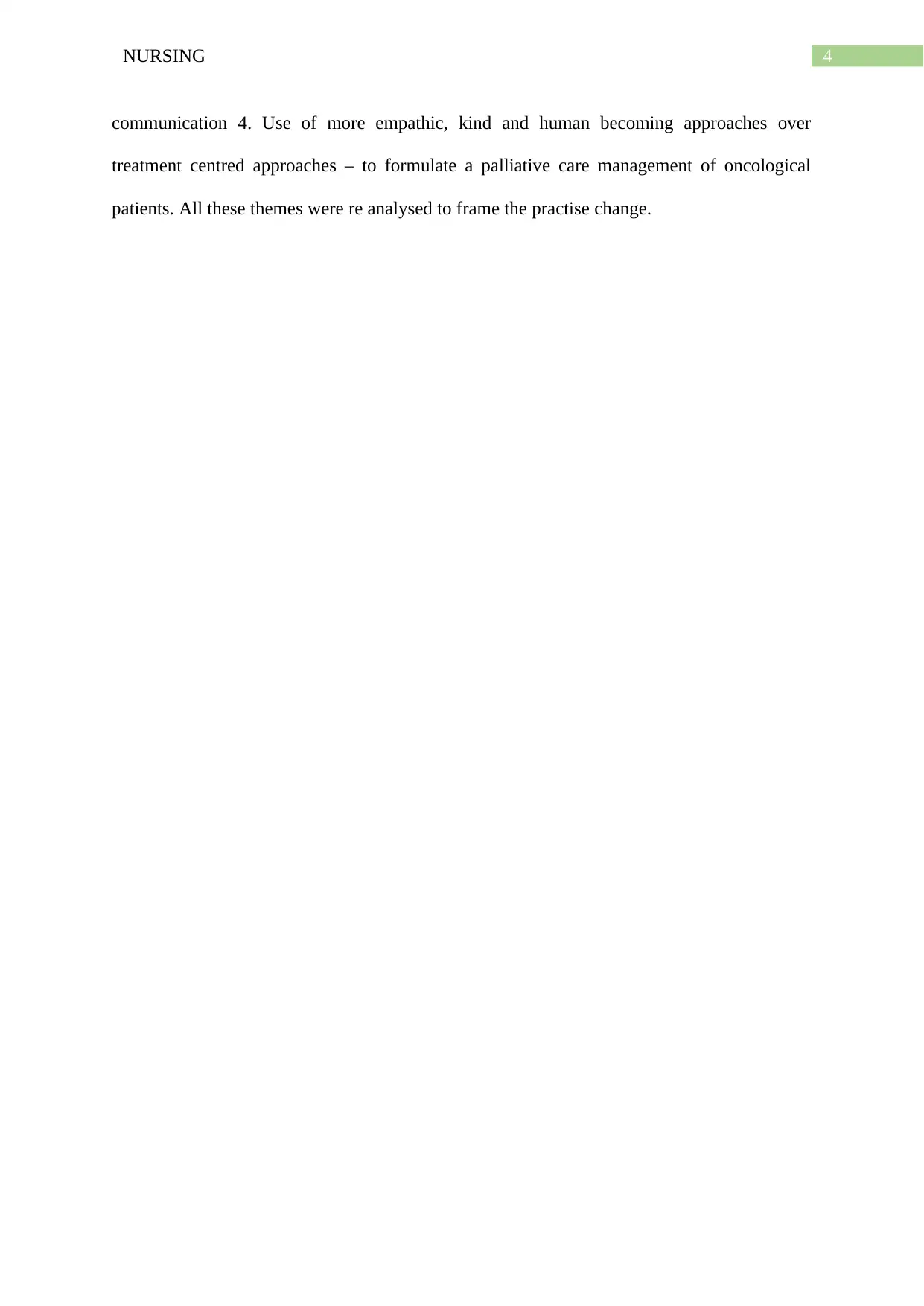
4NURSING
communication 4. Use of more empathic, kind and human becoming approaches over
treatment centred approaches – to formulate a palliative care management of oncological
patients. All these themes were re analysed to frame the practise change.
communication 4. Use of more empathic, kind and human becoming approaches over
treatment centred approaches – to formulate a palliative care management of oncological
patients. All these themes were re analysed to frame the practise change.
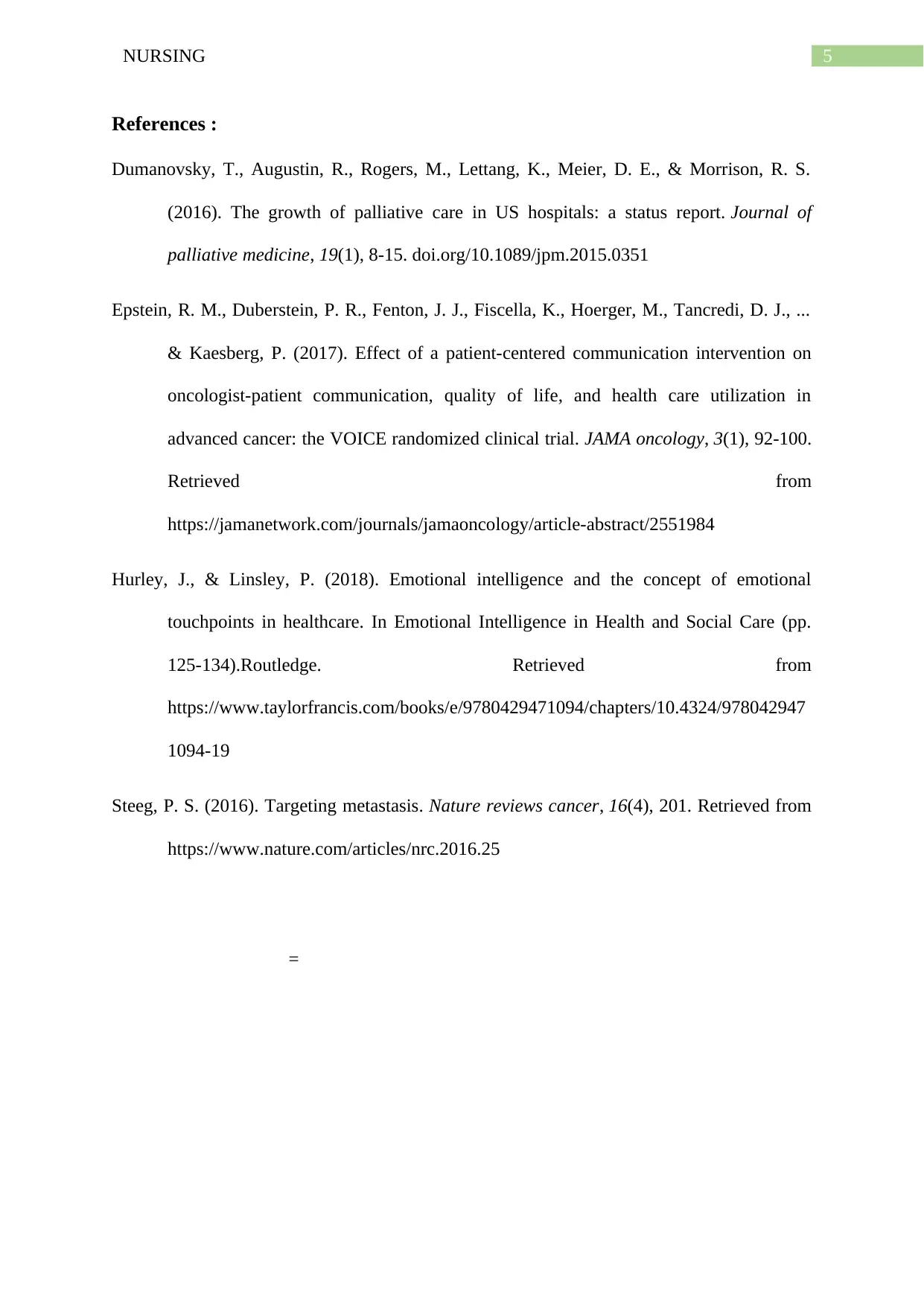
5NURSING
References :
Dumanovsky, T., Augustin, R., Rogers, M., Lettang, K., Meier, D. E., & Morrison, R. S.
(2016). The growth of palliative care in US hospitals: a status report. Journal of
palliative medicine, 19(1), 8-15. doi.org/10.1089/jpm.2015.0351
Epstein, R. M., Duberstein, P. R., Fenton, J. J., Fiscella, K., Hoerger, M., Tancredi, D. J., ...
& Kaesberg, P. (2017). Effect of a patient-centered communication intervention on
oncologist-patient communication, quality of life, and health care utilization in
advanced cancer: the VOICE randomized clinical trial. JAMA oncology, 3(1), 92-100.
Retrieved from
https://jamanetwork.com/journals/jamaoncology/article-abstract/2551984
Hurley, J., & Linsley, P. (2018). Emotional intelligence and the concept of emotional
touchpoints in healthcare. In Emotional Intelligence in Health and Social Care (pp.
125-134).Routledge. Retrieved from
https://www.taylorfrancis.com/books/e/9780429471094/chapters/10.4324/978042947
1094-19
Steeg, P. S. (2016). Targeting metastasis. Nature reviews cancer, 16(4), 201. Retrieved from
https://www.nature.com/articles/nrc.2016.25
=
References :
Dumanovsky, T., Augustin, R., Rogers, M., Lettang, K., Meier, D. E., & Morrison, R. S.
(2016). The growth of palliative care in US hospitals: a status report. Journal of
palliative medicine, 19(1), 8-15. doi.org/10.1089/jpm.2015.0351
Epstein, R. M., Duberstein, P. R., Fenton, J. J., Fiscella, K., Hoerger, M., Tancredi, D. J., ...
& Kaesberg, P. (2017). Effect of a patient-centered communication intervention on
oncologist-patient communication, quality of life, and health care utilization in
advanced cancer: the VOICE randomized clinical trial. JAMA oncology, 3(1), 92-100.
Retrieved from
https://jamanetwork.com/journals/jamaoncology/article-abstract/2551984
Hurley, J., & Linsley, P. (2018). Emotional intelligence and the concept of emotional
touchpoints in healthcare. In Emotional Intelligence in Health and Social Care (pp.
125-134).Routledge. Retrieved from
https://www.taylorfrancis.com/books/e/9780429471094/chapters/10.4324/978042947
1094-19
Steeg, P. S. (2016). Targeting metastasis. Nature reviews cancer, 16(4), 201. Retrieved from
https://www.nature.com/articles/nrc.2016.25
=
⊘ This is a preview!⊘
Do you want full access?
Subscribe today to unlock all pages.

Trusted by 1+ million students worldwide
1 out of 6
Related Documents
Your All-in-One AI-Powered Toolkit for Academic Success.
+13062052269
info@desklib.com
Available 24*7 on WhatsApp / Email
![[object Object]](/_next/static/media/star-bottom.7253800d.svg)
Unlock your academic potential
Copyright © 2020–2025 A2Z Services. All Rights Reserved. Developed and managed by ZUCOL.





